A Detailed Guide to the Internet of Things in Business: Benefits and Challenges
Updated 17 Jun 2023
15 Min
19733 Views
We've updated this article to provide you with the newest IoT trends and protocols.
The Internet of Things is one of the most promising spheres in the IT industry. Why is it so up-and-coming? The reason is global connectivity. Devices can cooperate with each other, just like groups of people. And as we know, cooperation significantly increases productivity.
IoT can be beneficial both for ordinary users and businesses. A lot of routine processes can be automated with sensors, scanners, cameras, and other devices running the right software. In this post, you’ll discover the strengths of IoT for business.
What is the Internet of Things?
Before we move on to the benefits of IoT, we have to figure out what IoT is itself. According to Wikipedia:
The Internet of things (IoT) is a system of interrelated computing devices, mechanical and digital machines provided with unique identifiers (UIDs) and the ability to transfer data over a network without requiring human-to-human or human-to-computer interaction.
Put it simply: IoT is meant to connect everything in the world. With the help of special protocols, devices can exchange data. Further, this data can be analyzed and turned into actions by devices using prewritten scripts.
Let’s take a closer look at each node of the IoT network.
Sensors
The primary stage of any IoT process is data gathering. Sensors that are meant to collect specific information, transmit the data to a recipient device. In turn, this device performs specific actions it’s programmed to make.
The simplest example are different kinds of IoT sensors in agriculture. When in the soil, they’re able to calculate the moisture level. If the soil is too dry, the sensor sends a signal to the irrigation device to start watering. This IoT network allows farmers to put the watering process on autopilot and cut irrational water expenses.
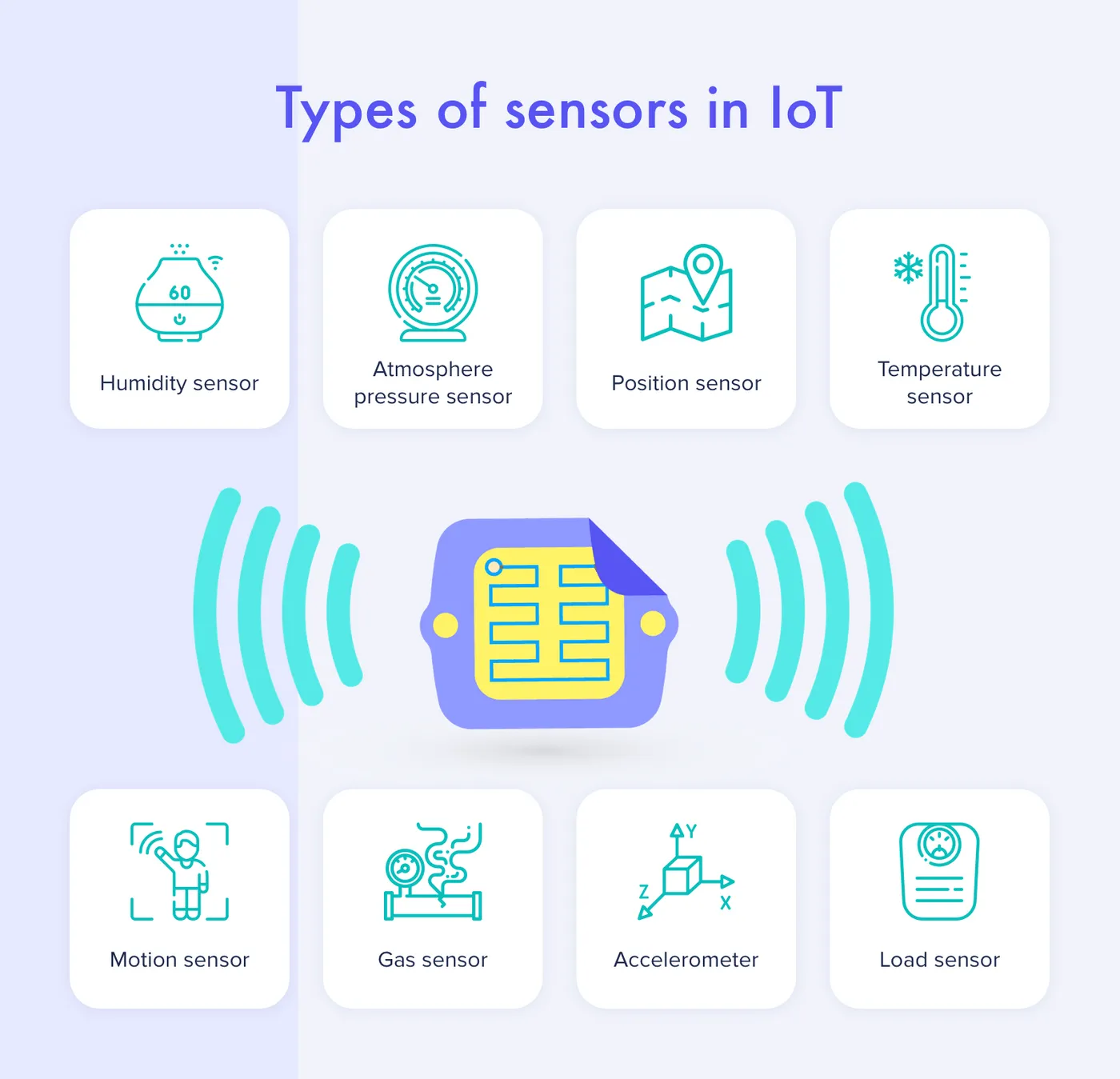
Main types of sensors for IoT
Connectivity
The whole process looks simple on paper. In reality, communication between sensors and devices is a very complicated part of the network. It’s obvious that IoT requires a wireless connection for running on remote devices. That’s why the majority of connectivity protocols use following technologies:
- Wi-Fi
- Bluetooth
- Cellular networks (4G/5G)
These means of connection are widely spread, so a lot of devices are compatible with them.
If you need a smaller connectivity range, you can use:
- NFC
- RFID protocols
NFC’s (near field communication) range is only around 4 cm. Nevertheless, it lets you use a smartphone as a multi-purpose tool that can read the data from any device with an NFC module. For example, smartphones can exchange data with working equipment to check it's condition in manufacturing facilities.
I’ll cover more IoT protocols in the next sections.
Analytics
Sensors gather large clusters of information daily. These clusters contain data that may be useful for your business. But, you have to separate it from non-helpful data before you can use it. That’s where analytics can help.
A powerful IoT system can analyze data in real-time and give end-users detailed information about anomalies. Top-tier companies use the collected data to expand their business opportunities.
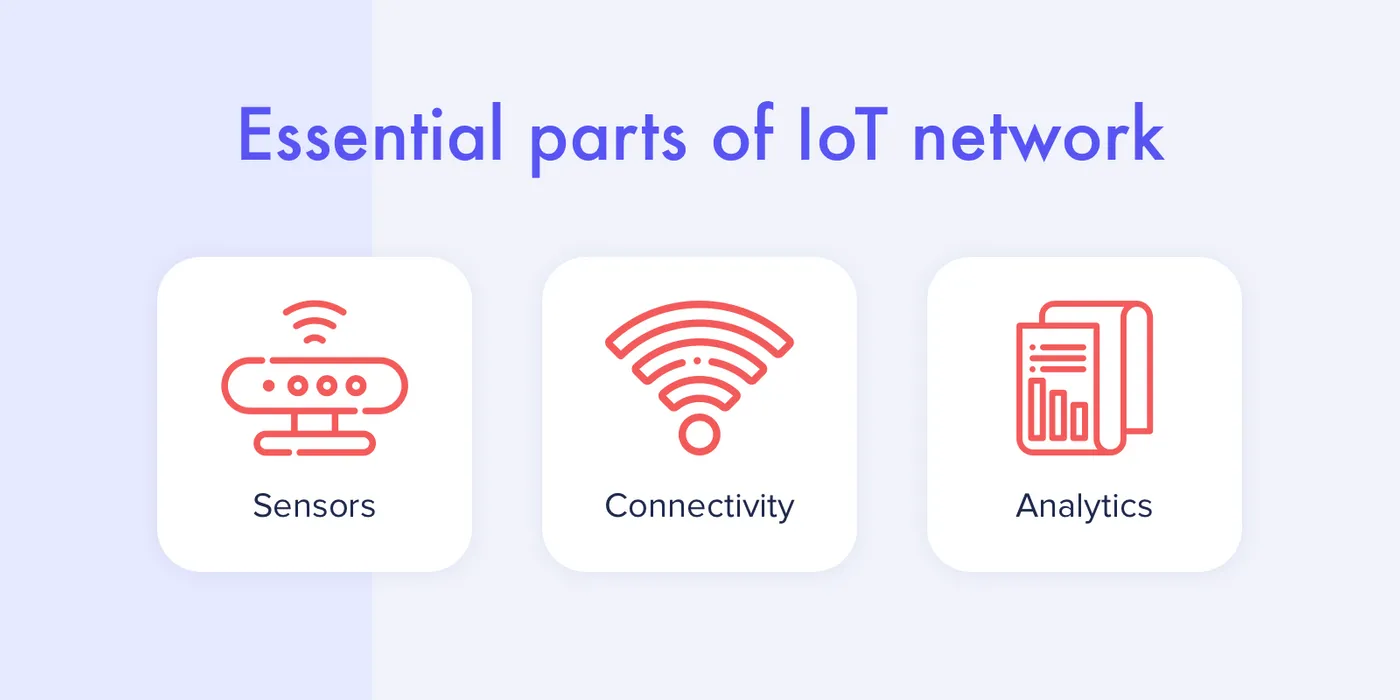
3 main components of an IoT network
How IoT Influences Businesses?
Since you already know the basics, it's time to learn more about IoT opportunities for business.
Before exploring the Internet of Things use cases in business, we will consider it’s marketing potential. Let’s take a retail field first. With the help of beacons, small radio transmitters that can detect your location, analysts can understand what kinds of products are popular among customers. By comparing data, like the time spent near the counter, customers’ routes, and the types of purchased goods, analysts can replace the goods focusing on customers' needs.
Besides, beacons can be used for shop exit interviews. When customers exit the store, an app offers them to answer questions about satisfaction level, ease of use, further expectations about your shop, and more.
Now, let’s consider IoT business opportunities. The main purpose of the Internet of Things in business is automating various processes so that human interference isn’t necessary.
So, let’s find out what spheres can benefit from IoT.
Discover more IoT business opportunities to find out which one to apply for an excellent startup
What Businesses Can Benefit From IoT?
Today, there’s a countless number of business fields. Entrepreneurs of each field want to increase revenue, and IoT can provide some assistance to them. Here’s a list of industries that may benefit from IoT solutions.
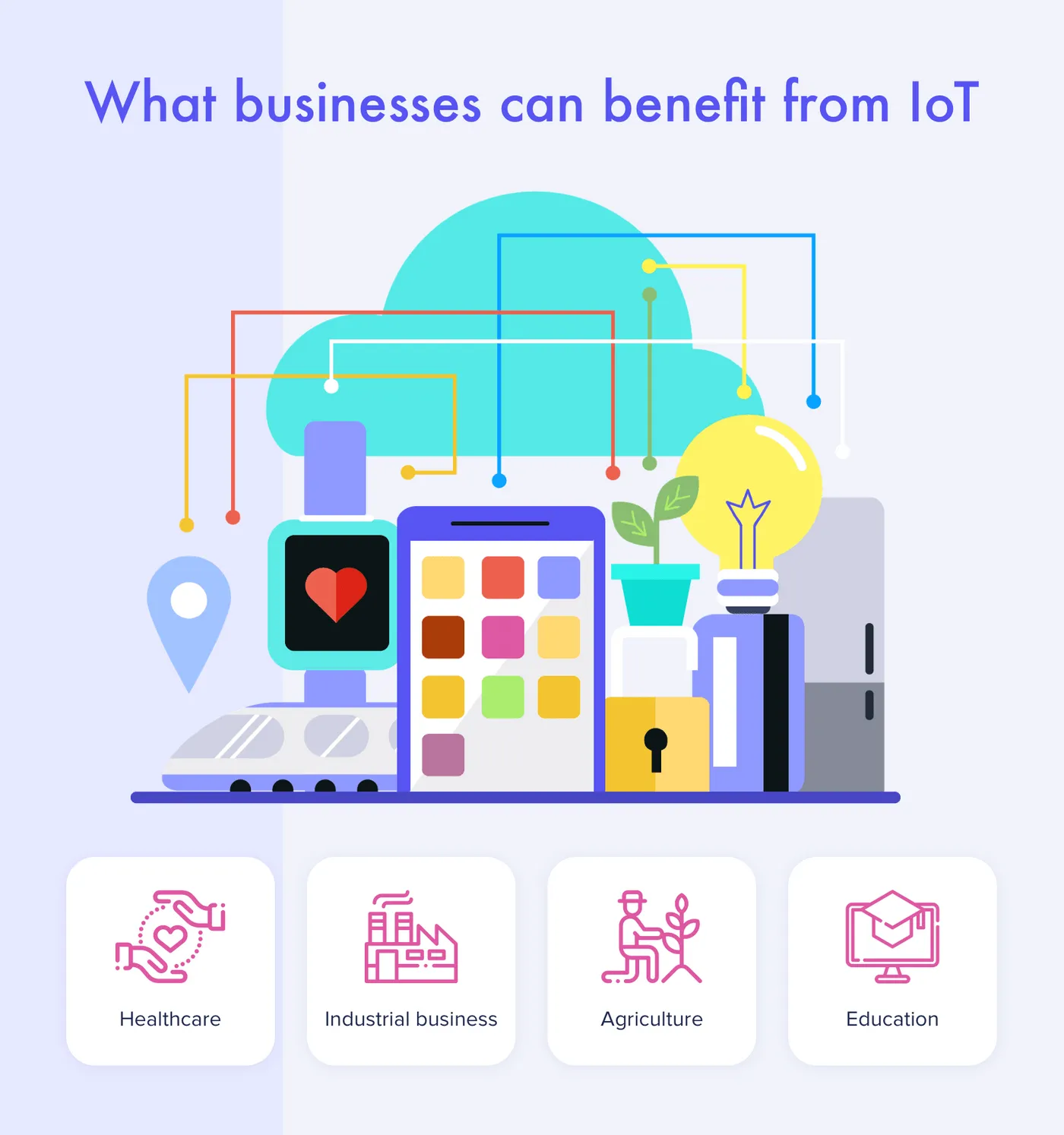
Primary business fields for IoT
Healthcare
A gold mine for entrepreneurs and an integral part of life for clients. Which IoT use cases in healthcare can be beneficial to both sides? First and foremost — wearables.
Wearable devices let doctors monitor a patient's condition without even visiting their room. With a basic network of devices (fitness trackers, scales, and smartphones) doctors can stay updated about general stats like heart rate and weight. In case if any indicators are above or below normal, doctors can immediately reach out to the patient and give them instructions. However, an IoT network won’t work without custom software. That’s why an experienced software development company is a necessary component of any IoT project.
Another, more targeted, Internet of Things use case is a smart asthma inhaler. Findair is equipped with a GPS module. Whenever a patient leaves the device behind, it sends a push notification to the phone. It also analyses environmental data and suggests agents causing the asthma attack. On top of that, a mobile app keeps records of inhaler usage.
The last IoT use case for healthcare left is a smart drug dispenser. This device gives medications to patients on schedule. A Hero dispenser is an outstanding example that can sort and manage pills without the user's involvement. It also has a button for manual access to drugs.
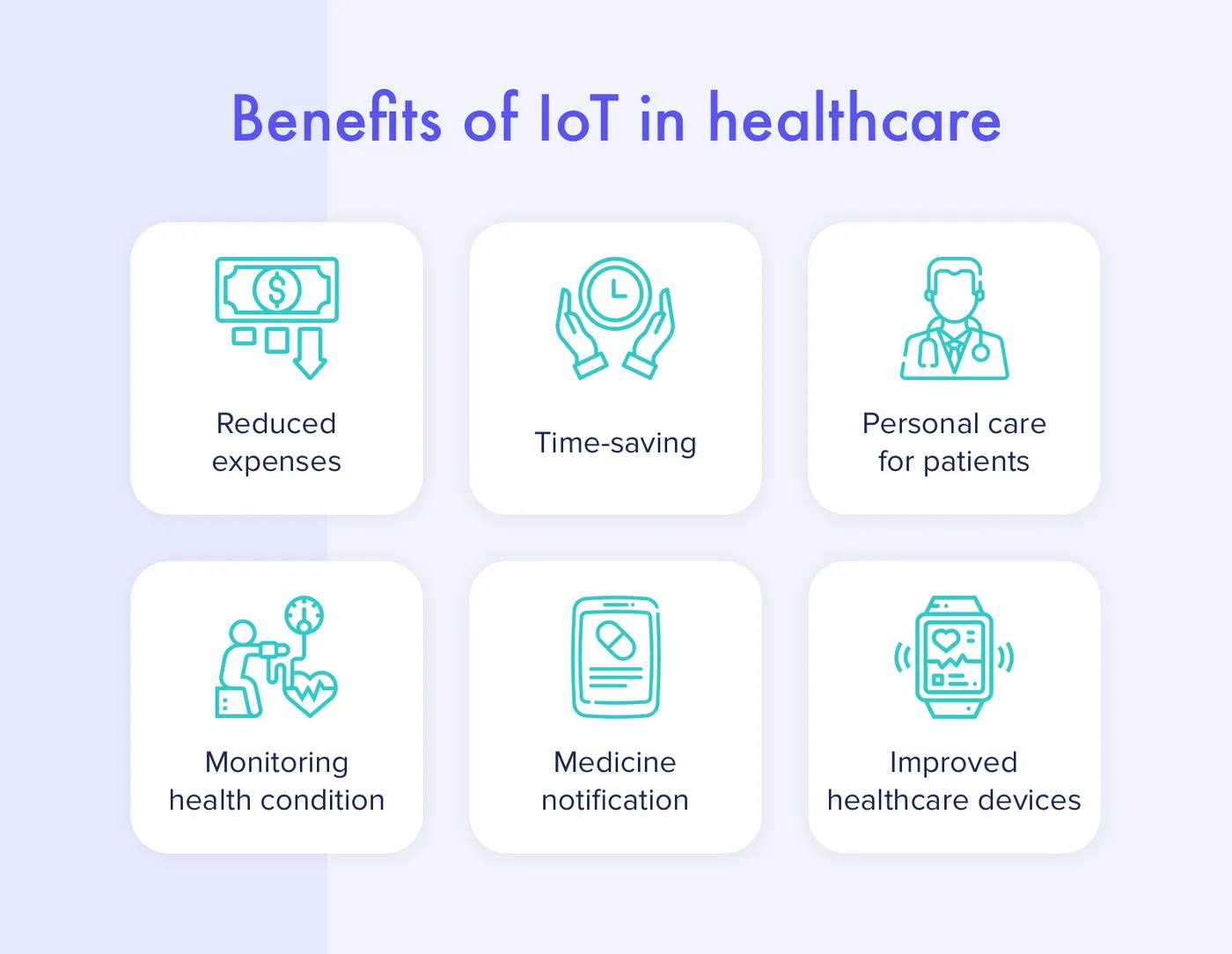
IoT business opportunities in healthcare
Want to learn more about Internet of Things in healthcare? Check out our article to find out all of it's strengths and weaknesses.
Industrial Business
IoT use cases in manufacturing and industrial spheres are unlimited. Due to complex manufacturing facilities, IoT devices can be applied to a vast range of equipment. Industrial IoT startups let companies track product quality, monitor equipment condition, and gather analytics.
Equipment is a vital part of every factory. The bigger the factory is, the more equipment it usually has. It may take a lot of time to inspect and maintain broken pieces of gear. Machine Vision is an Indonesian startup that allows managers to monitor overall equipment efficiency. With the help of sensors, it provides detailed statistics about the root cause of the problem, identifies problems that cause bad outcomes in manufacturing. Besides, it lets you monitor several plants at a time from a single place.
Another IoT use case in the manufacturing industry is monitoring product quality. In most cases, you notice a defect after the product is already made. However, companies specializing on smart solutions creation, allows workers to monitor the machine outcome in real-time. With this feature, you may fix the issue instantly and get a proper product.
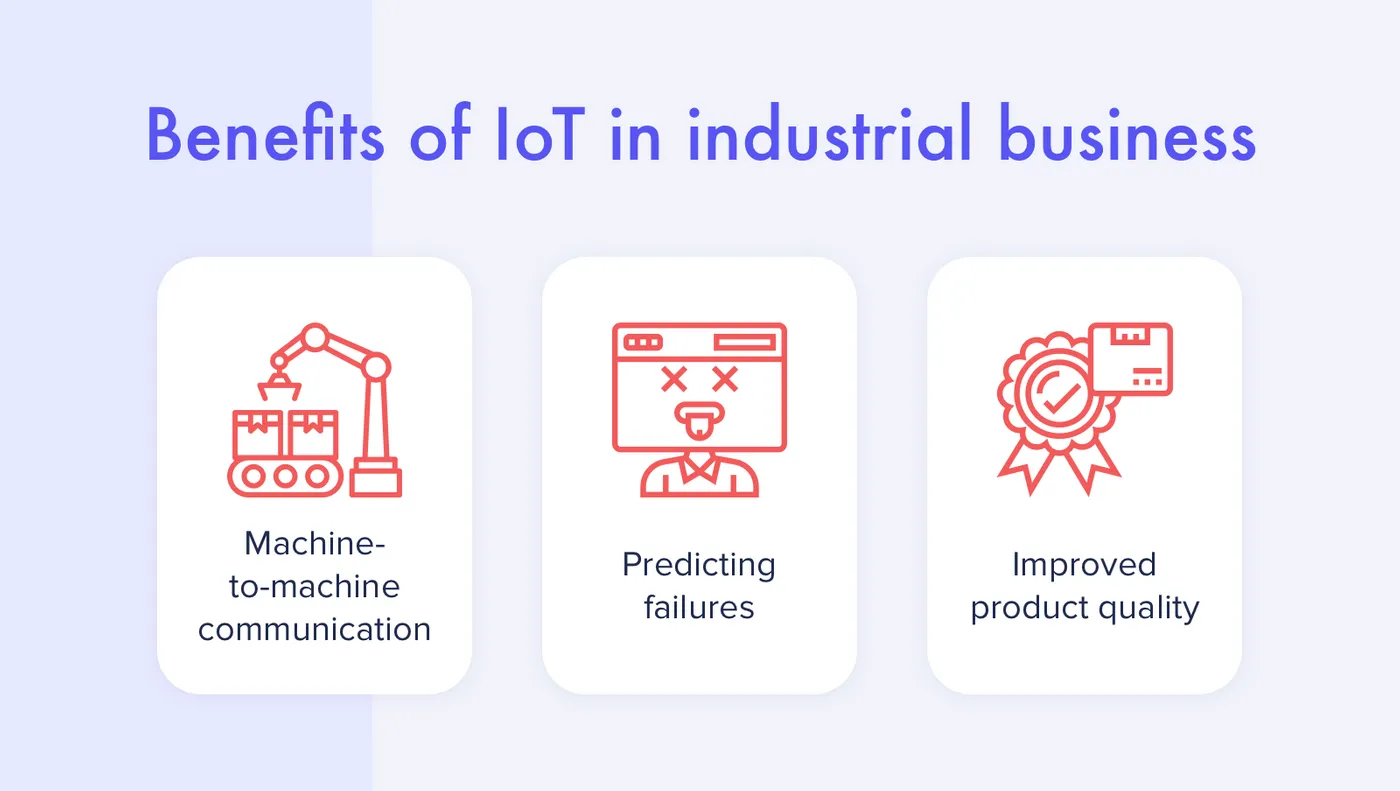
The effect of IoT on industrial business
Agriculture
Farming is always linked to large land areas . One of the main advantages of IoT for businesses is that devices can work in hard-to-reach zones and handle large squares without productivity losses. Plowing, fertilizing, and watering are labor-intensive activities. So, IoT devices are meant to ease farmers’ work.
The most well-known example of IoT in agriculture are drones. Modern drones built specifically for industrial work can carry up to 600 pounds, which makes them a great tool for soil fertilization . For example, DJI has it's own agriculture drone that fertilizes 7-10 acres per hour. It’s much faster than the average employee, because the drone doesn’t have any obstacles above the ground. Some drones can fly pre-programmed routes on autopilot. However, they still need a supervisor because this technology is not yet perfect.
Among the companies using IoT, we can find an agricultural giant John Deere. Here’s what Lane Arthur, Director of digital solutions at John Deere, says about the IoT benefits for business.
Lane Arthur
Director of digital solutions at John Deere
History has been to make machines bigger and faster, and they’ve switched their strategy a bit to say ‘you know what, we need to make them smarter and more precise. They have embedded a number of IoT technologies into their machines, in order to better understand what the machine is doing, but better understand how the machine is doing the work the farmer or grower expects the machine to do.
John Deere managed to create sensors that control the precision of planting seeds and how the planter interacts with the soil. For now, John Deere’s solutions for agriculture are one of the most advanced on the market.
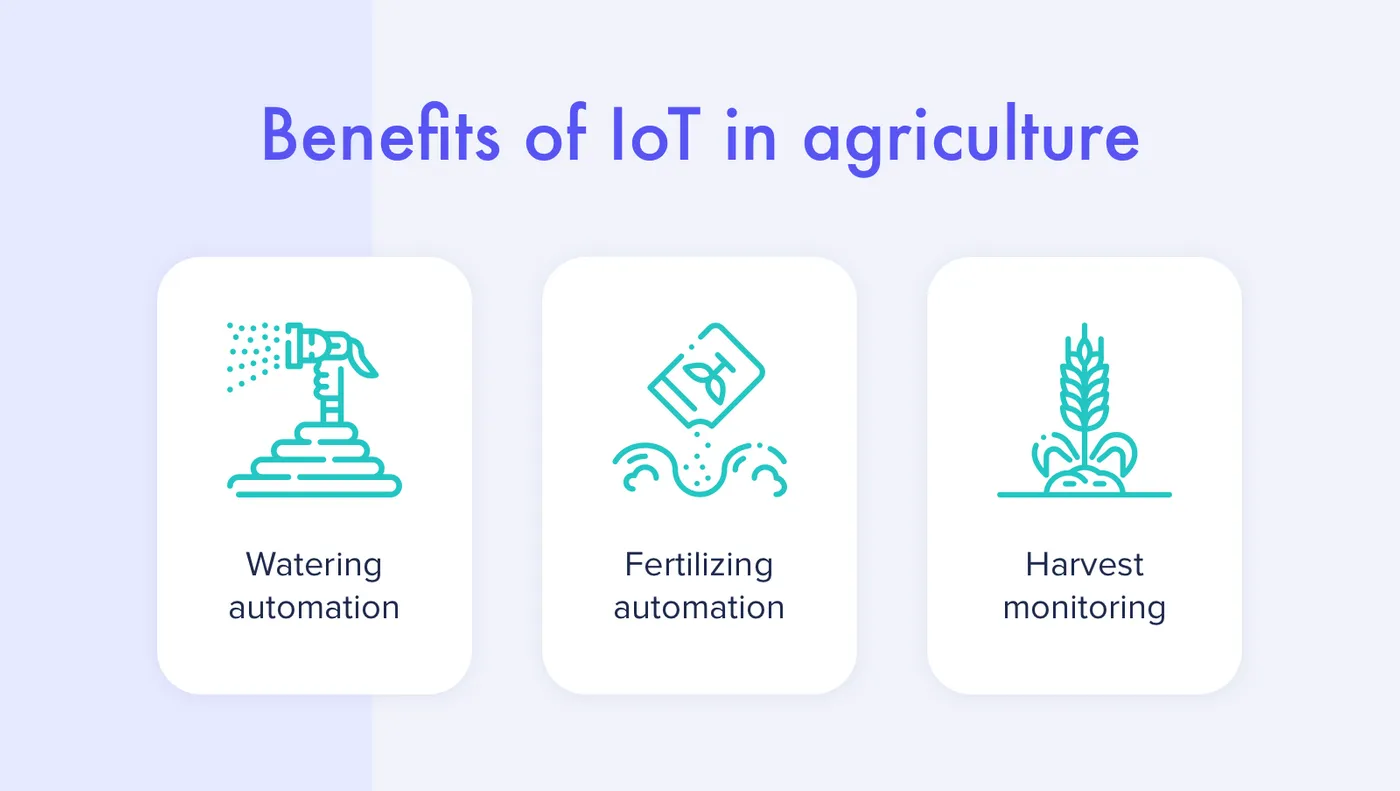
The effect of IoT on agriculture
Education
Let’s take a brief overview of IoT use cases in education. IoT in education can help both students and teachers. Schools can use it for security, libraries, communication, and so on.
Security is above everything, especially when it comes to children. Usually, each school has a security guard at the front door. However, a single person can’t safeguard the whole facility. That’s why IoT solutions offer IP cameras, motion sensors, and biometric scanners. With all these equipment connected, there will be no trespassers in the facility.
Another IoT use case in education is geofencing. With the help of beacons and a custom map, you can guide students through the building. All students have to do is download the map and enable geolocation on their phones. Their position will be tracked down with great precision due to geofencing accuracy.
As for the educational process itself, RFID tags coupled with specialized software can automatically keep track of who’s present in classes. This option saves several minutes of the teacher’s time in every class. On top of that, teachers can keep a record of each student’s performance, grades, strengths, and weaknesses.
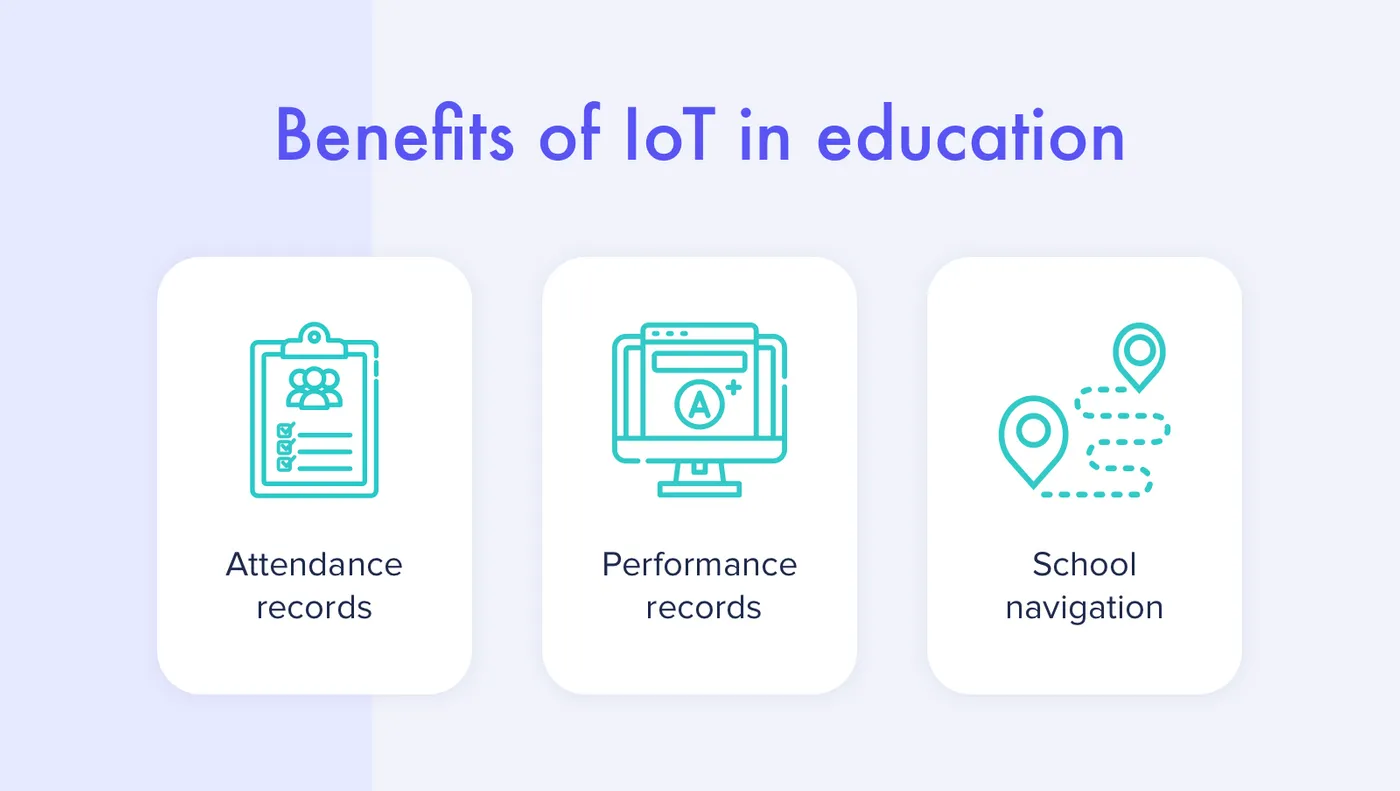
The effect of IoT on education
Companies Using IoT Technologies
Now you’ve got better acquainted with IoT benefits for business and understand the connection between the Internet of Things and business. So, we’ll move on to companies using IoT.
AeroFarms
AeroFarms is a brand new way of managing vertical farms. Conventional vertical farms use a hydroponic system for planting seeds. Thus, it doesn’t require any soil. However, AeroFarm went further combining data science and IoT.
The technology used in growing is known as aeroponics. It feeds the plant with nutrients through a reusable fabric. At the same time, IoT sensors analyze the stress level of the plant. With the help of data science, researchers are trying to find the stress level that boosts their growth speed. It’s worth mentioning that watering and fertilizing processes are automated, so they’re much more financially efficient.
Mustang
Mustang is a Russian provider of dairy production analytics. Their primary goal is to increase it's customers' profit by using new cattle care methods. IoT sensors gather the data about temperature, humidity, atmosphere pressure. Then, analysts are looking for a correlation between those conditions and cow lactation. All the devices communicate with each other via the LoRaWAN protocol. Mustang is one of the best IoT in business examples because of the scalability. Due to the portability of IoT devices, this company can provide consulting services to any farm, while research can be held in the main laboratory.
eWaterPay
A simple yet gorgeous solution for remote villages with hard access to water sources. In African villages, people have to go to the nearest bottling plant to get some water. Instead, eWaterPay offers an alternative in the form of a vending machine.
Those who want to use it should get a special RFID tag. When a user puts this tag close to their phone, it writes off a small amount of money from their bank account. Then users attach the tag to the vending machine to get their water. This is an IoT business opportunity that is not only affordable but also can save human lives.
Internet of Things Protocols
We’re done with IoT business opportunities and Internet of Things use cases. Let’s get to the most frequently used IoT standards and protocols used for communication between devices.
Wi-Fi
One of the most common protocols for a medium-range device connection. The 802.11 standard has a great bandwidth that allows you to operate with a large amount of data. However, the range leaves much to be desired. The area of Wi-Fi coverage is around 50 meters. Even though the range can be extended with the help of transmitters, signal quality will be worse. Also, Wi-Fi modules have strong power consumption. This may be a significant problem for small devices that don’t have a large battery.
Bluetooth
This IoT protocol fights with Wi-Fi for the first place. Bluetooth Low Energy brings the protocol on a new level. It opens new opportunities for devices with small battery capacity. However, the range of this protocol is even less than Wi-Fi has. Besides, the data exchange speed is suitable only for small sized-files. Minding these facts, we can see that Bluetooth is a perfect option for wearable devices.
NFC
Most of us know NFC due to contactless payments. But only a few know that it’s also a great IoT communication protocol. NFC stands for Near Field Communication, and it's range lives up to it's name. The coverage area is only 10cm, but it has it's particular benefits. This IoT protocol delivers a secured two-way communication. That means you can transfer valuable information without the risks of interception.
Besides, this protocol can be used as an additional way of communicating with devices. For example, you may have an IoT network based on Wi-Fi. To connect a new device to the network, you have to send it a configuration file first. In order to not overload your main network, you can use a different IoT protocol. NFC is your best shot because of safety and transferring speed.
Got lost in protocols?
Our analysts can help you define the best protocol for your IoT solution free of charge!
4G/5G
When the 5G arrives, the world of IoT may change forever. The coverage of cellular networks is unlimited. Almost any part of the US has a 4G network, so there are no obstacles to communication between devices. The 4G speed of data transmission is high, not to mention 5G with it's gigabit speed.
This IoT communication protocol is excessive for small businesses and may be used in smart cities or dealing with large areas. However, everything has it's price. The data sending rates are quite high. So, entrepreneurs have to pay extra or find cheaper alternatives.
ZigBee
Another popular communication protocol used by IoT powered industrial companies. It’s less consumer-friendly for the average user because of it's frequency. This IoT protocol operates at 2.4 GHz, which may not be enough for smart house utilities, but is fairly enough for small clusters of data on industrial sites. ZigBee is also considered a secured and low-energy consuming protocol.
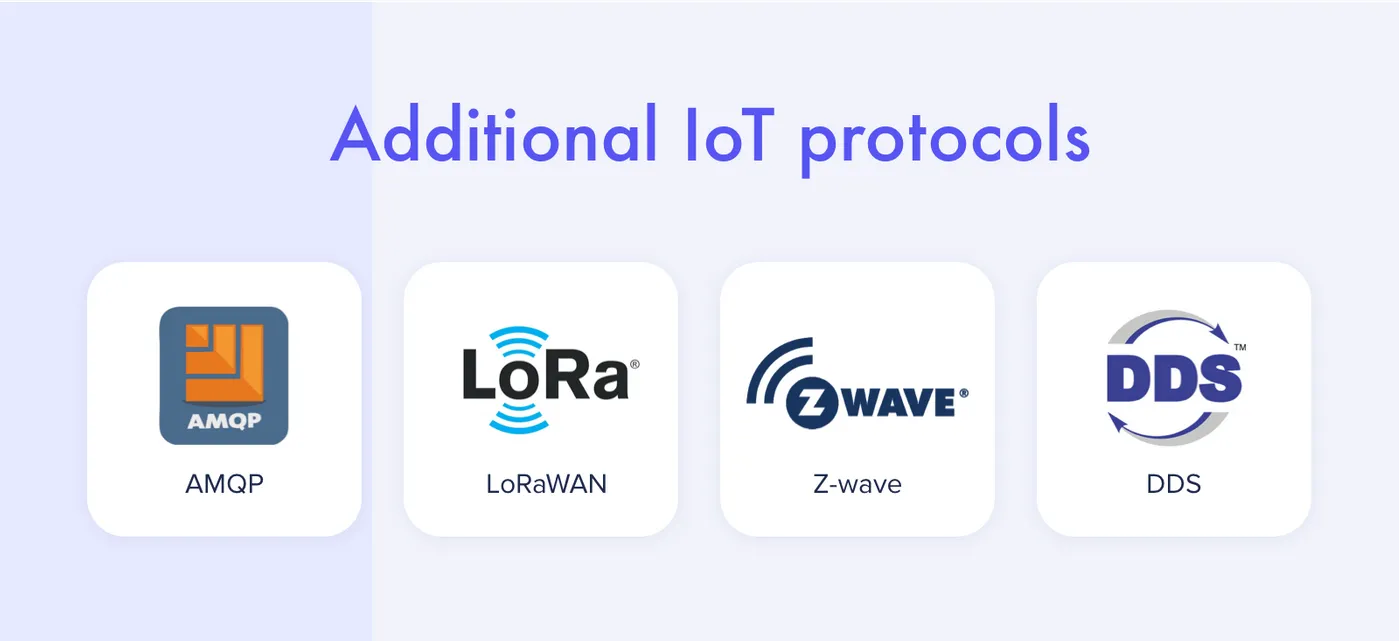
Some more IoT communication protocols
IoT Risks and Challenges
Despite all of IoT opportunities and benefits, it still has some considerable drawbacks. Challenges of securing IoT devices, scalability issues, and lack of investments make it hard to establish an IoT network. Let’s find out what can be wrong with this technology.
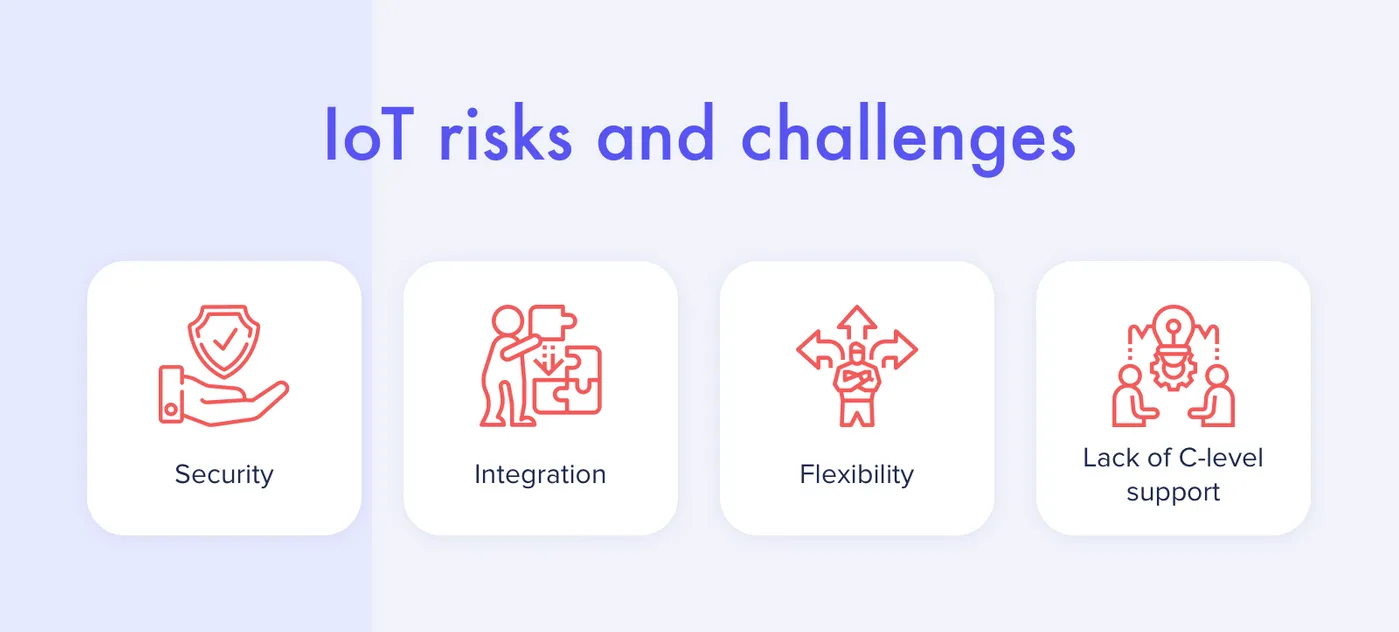
Major IoT pitfalls
IoT Security Challenges
According to Cisco, 75% of discovered vulnerabilities were found in IoT devices and networks. That means that IoT still lacks reliable security standards, so hackers can gain access to sensitive data. That’s why it’s crucial to take care of each device’s security while developing an IoT network. There are two solutions to this problem. The first one is developing a custom security system. It should have firewalls, two-step verification, encryption methods, and so on. This path requires you to hire cybersecurity specialists and waste a lot of time for development.
The second solution is to apply turn-key products from top-tier IoT companies. Cisco, Darktrace, Senrio are the companies that offer security products for enterprise-level IoT. Ready-made solutions are easier to implement, but they may not suit your needs. That’s why you have to decide what’s better in your specific case.
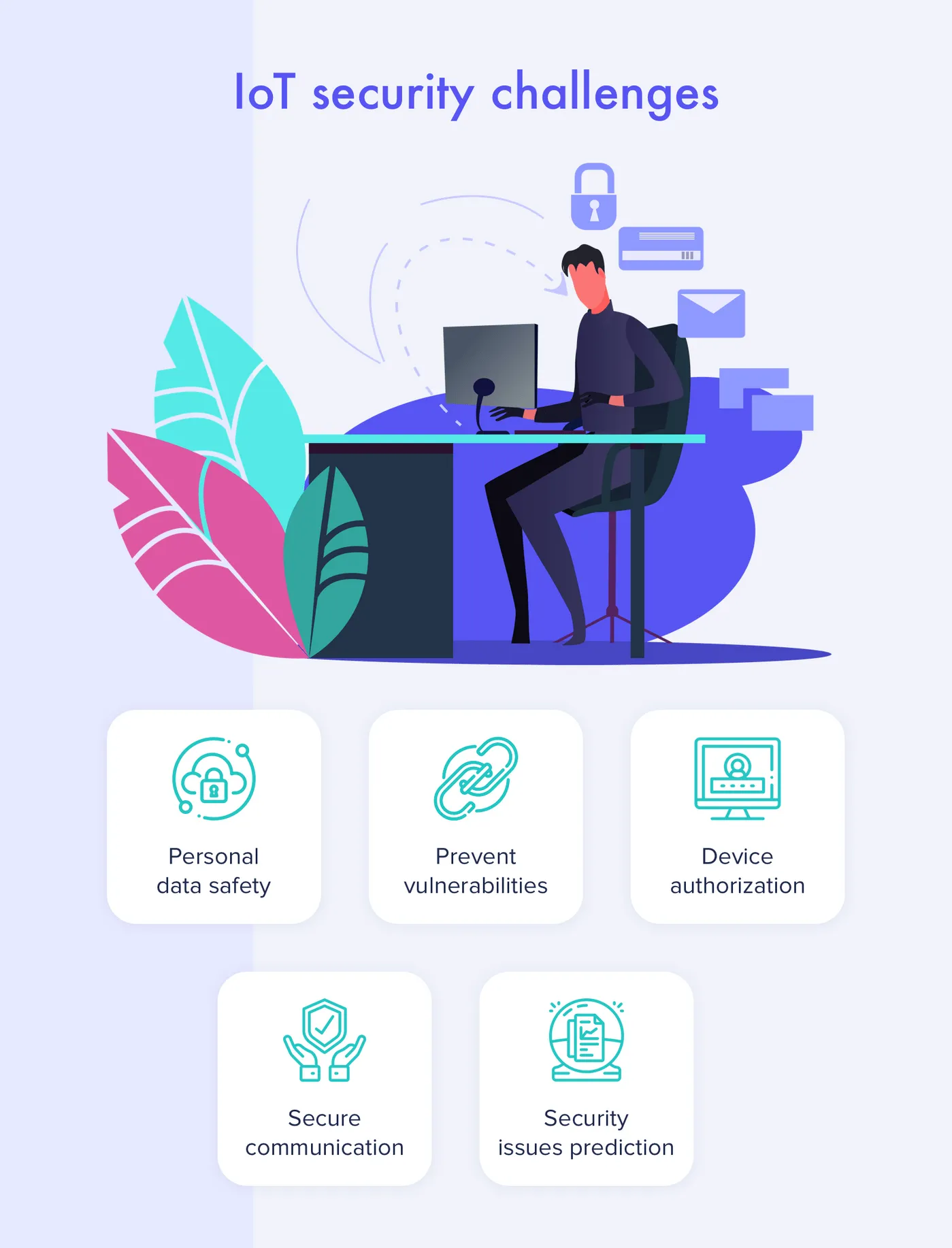
Main security issues of IoT in business
Integration
Another point among challenges and issues in IoT devices integration. Without regard to industries, IoT devices may not be compatible with each other. There are many reasons why this happens. Different manufacturers or different operating systems may lead to system failures. Because of the market competition, it’s better to stick to a certain manufacturer and build an ecosystem of similar devices around it. Devices of the same brand will most likely use common IoT protocols and won’t have any compatibility issues.
Flexibility
IoT is a relatively new technology for business. For today, there are no conventional use cases and strategies that guarantee a boost to your business. Companies using IoT business opportunities have to be creative and accurately measure success chances. On top of that, most of the companies don’t have the specialists that can operate with IoT systems. That means entrepreneurs have to engage an outsourced software development company for integration and further extension of the IoT network.
Choosing a software development company? With this article, you’ll know what you should pay attention to and how to arrange meetings with the company.
Lack of C-Level Support
Despite the obvious IoT benefits for business, sometimes managers don't pay proper attention to this technology. They mostly think that IoT is beyond real, and it’s too hard to implement it. Besides, there may be more important issues to solve, so companies aren’t rushing for modern tendencies.
Unfortunately, these entrepreneurs are making a mistake, because the future of businesses is in IoT. Sooner or later, most companies will integrate this technology. And the faster it happens, the more profit companies will be able to generate thanks to IoT systems.
Have an IoT business idea?
We can help you with the feature list and estimate the integration cost for free!
The main purpose of the Internet of Things in business is automating various processes so that human interference isn’t necessary. So, IoT can take the load off your employees and exclude the chance of human mistake.
IoT is meant to connect everything in the world. With the help of special protocols, devices can exchange data. Further, this data can be analyzed and turned into actions by devices using prewritten scripts.
The biggest IoT security challenges are:
- Preventing vulnerabilities
- Communication security
- Personal data safety
- Managing software updates
- Security issues prediction
Generally, businesses use IoT for automation of work processes and analysis of gathered data. IoT allows them to reduce the workload and extract useful data for further researches.
Here are the ten best protocols used for building IoT networks:
- Wi-Fi
- Bluetooth
- Cellular networks (4G/5G)
- RFID
- NFC
- ZigBee
- DDS
- LoRaWAN
- AMQP
- Z-Wave
Top-tier companies that use IoT to automate routine processes are:
- Amazon
- Rolls-Royce
- John Deere
- Daimler Startups also find a use for IoT solutions. Here's a short list of smaller companies and startups that use IoT:
- AeroFarms
- Mustang
- eWaterPay

Evgeniy Altynpara is a CTO and member of the Forbes Councils’ community of tech professionals. He is an expert in software development and technological entrepreneurship and has 10+years of experience in digital transformation consulting in Healthcare, FinTech, Supply Chain and Logistics
Give us your impressions about this article
Give us your impressions about this article
